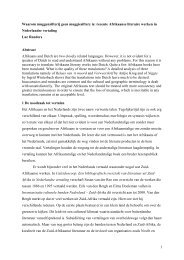Planning Problems in Intermodal Freight Transport ...
Planning Problems in Intermodal Freight Transport ...
Planning Problems in Intermodal Freight Transport ...
Create successful ePaper yourself
Turn your PDF publications into a flip-book with our unique Google optimized e-Paper software.
The comb<strong>in</strong>ation of both classes provides a classification matrix with twelve<br />
categories of <strong>in</strong>termodal operations problems, as depicted <strong>in</strong> Table 1. The classification is not<br />
exhaustive and some decision problems can be faced by several decision makers and can be<br />
relevant for the same decision maker at different time horizons. However, the decision<br />
problems have been placed <strong>in</strong> the classification matrix of Table 1 were they are most<br />
prom<strong>in</strong>ent. Table 1 provides a structured overview of plann<strong>in</strong>g problems <strong>in</strong> <strong>in</strong>termodal<br />
transport <strong>in</strong>volv<strong>in</strong>g a s<strong>in</strong>gle decision level and a s<strong>in</strong>gle decision maker. Section 3 discusses<br />
studies on strategic plann<strong>in</strong>g problems. Papers on a tactical decision level are presented <strong>in</strong><br />
section 4. Section 5 deals with scientific research on <strong>in</strong>termodal transport at the operational<br />
decision level. Two separate tables have also been constructed. Table 2 compiles scientific<br />
research <strong>in</strong> <strong>in</strong>termodal transport <strong>in</strong>volv<strong>in</strong>g multiple decision makers. Table 3 presents studies<br />
that explicitly take <strong>in</strong>to account multiple decision levels. These <strong>in</strong>tegrat<strong>in</strong>g studies are<br />
discussed <strong>in</strong> section 6. The number of studies that require decisions from more than one<br />
decision maker or that cover various time horizons are very limited. This important<br />
conclusion has been formulated already by Macharis and Bontekon<strong>in</strong>g [3]. We f<strong>in</strong>d that little<br />
improvement has been realised <strong>in</strong> recent years. However, <strong>in</strong>termodal transport, by def<strong>in</strong>ition,<br />
<strong>in</strong>volves several decision makers who need to work <strong>in</strong> collaboration <strong>in</strong> order for the system to<br />
run smoothly. An <strong>in</strong>creased level of coord<strong>in</strong>ation is necessary to improve the <strong>in</strong>termodal<br />
transport flow. If <strong>in</strong>termodal transport is to be developed it will require more decision-mak<strong>in</strong>g<br />
support tools to assist the many actors and stakeholders <strong>in</strong>volved <strong>in</strong> <strong>in</strong>termodal operations. A<br />
very good attempt at outl<strong>in</strong><strong>in</strong>g these tools can be found <strong>in</strong> Van Du<strong>in</strong> and Van Ham [5] <strong>in</strong><br />
which a three-level modell<strong>in</strong>g approach is followed <strong>in</strong> order to take account of the different<br />
goals of the different stakeholders.<br />
Table 1. Papers <strong>in</strong>volv<strong>in</strong>g a s<strong>in</strong>gle decision level and a s<strong>in</strong>gle decision maker









